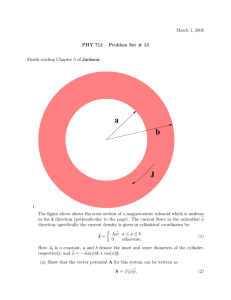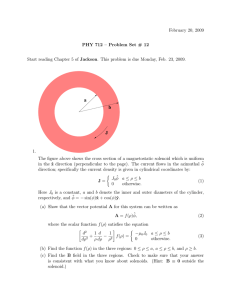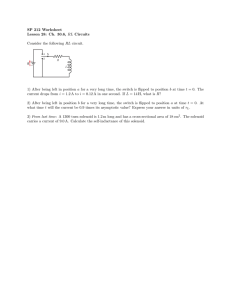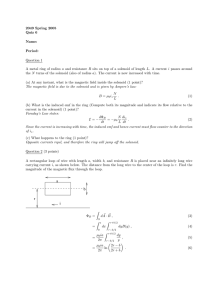μ B fields from a single current
advertisement
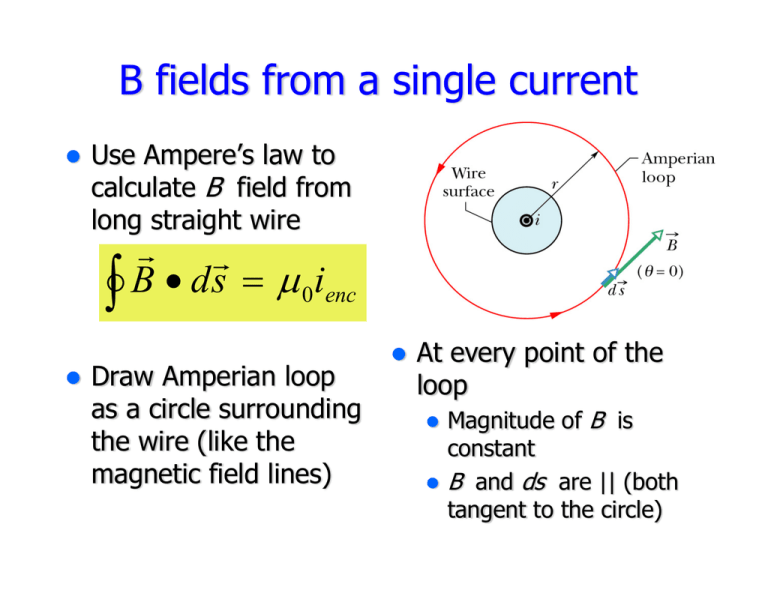
B fields from a single current z Use Ampere’s law to calculate B field from long straight wire r r B • d s = μ i 0 enc ∫ z Draw Amperian loop as a circle surrounding the wire (like the magnetic field lines) z At every point of the loop z z Magnitude of B is constant B and ds are || (both tangent to the circle) B fields from a single current z B and ds are || so cosθ = cos0 = 1 r r B • ds = Bds z B constant on loop so r r B • d s = B ds ∫ ∫ ∫ ds = 2π r r r B • d s = B ( 2 π r ) ∫ B fields from a single current z Ampere’s law becomes B ( 2π r ) = μ 0ienc z Current enclosed is just i so μ 0i B= 2π r z Same result as with Biot-Savart law (we used r=R before). B fields from solenoids z z z z What happens if there are several loops of wire put together? A long, tightly wound helical coil of wire is called a solenoid Bend solenoid so ends meet to make a hollow donut gives a toroid Use Ampere’s law to calculate B field for a solenoid and a toroid B fields from solenoids Solenoid’s B field is vector sum of fields produced by each turn (loop) in solenoid B fields from solenoids z z z Near each loop it looks like an infinite straight wire Between the loops fields tend to cancel Inside the solenoid, far from the wire, B field is parallel to axis z An ideal solenoid z z is infinity long with closely packed turns of wire has uniform B field which is parallel to solenoid axis B fields from solenoids z z z For points outside the solenoid B fields from the upper parts of the turns tend to cancel the lower Ideal solenoid Boutside=0 For a real solenoid can assume Boutside=0 if z z length >> diameter Only consider points not near ends of solenoid z Use right-hand rule to find direction of B field z Grasp solenoid so fingers follow direction of i in loops, thumb points in B B fields from solenoids z Use Ampere’s law to calculate B field of ideal solenoid z Draw Amperian loop a-b-c-d-a intersecting solenoid B fields from solenoids r r ∫ B • d s = μ 0ienc z Integral can be written as sum of four integrals, one for each side r r br r cr r ∫ B • ds = ∫ B • ds + ∫ B • ds a b r r ar r + ∫ B • ds + ∫ B • ds d c d B fields from solenoids z b ∫ First integral B field is || to ds r r B • d s = B [s ] ba = Bh a z z For sides bc and da B is ⊥ to ds so For the length outside the solenoid B=0 d r ∫ c r B • ds = 0 c ∫ r r B • ds = b a ∫ r r B • ds = 0 d ∫ r r B • d s = Bh B fields from solenoids z Now need to find amount of current enclosed ∫ z z z r r B • d s = μ 0 i enc Single coil has current i But Amperian loop encloses several coils so total current is where n is the number of turns per unit length i enc = inh N n= L z z N = total # of turns L = length B fields from solenoids z Substituting into Ampere’s law ∫ r r B • d s = μ 0 i enc Bh = inh z For ideal solenoid: B = μ0in z n is # turns/length z B field of solenoid z z does not depend on diameter or length of solenoid is uniform over its cross section B fields from toroids z Calculate B field for a toroid using Ampere’s law ∫ z z r r B • d s = μ 0 i enc Choose Amperian loop to be a concentric circle inside toroid B and ds are parallel along entire loop so r r ∫ B • ds = B ∫ ds = B ( 2πr ) B fields from toroids z Current enclosed by loop is i enc = iN ∫ r r B • d s = μ 0 i enc B( 2πr ) = μ0iN z B field for toroid is μ0iN B= 2πr B fields from toroids z Toroid – B field is not constant over its cross section μ0iN 1 B= 2π r z z N = total # of turns Use right-hand rule to find direction of B field z z Grasp toroid with fingers in direction of current in windings, thumb points in B B = 0 outside toroid B fields from finite wires z Ampere’s law becomes B ( 2π r ) = μ 0ienc z Current enclosed is just i so μ 0i B= 2π r z Same result as with Biot-Savart law (we used r=R before). B fields from finite wires z Calculate B field inside a long straight wire r r ∫ B • ds = μ0ienc z Again B and ds are || and B is a constant so r r ∫ B • ds = B ∫ ds = B ( 2πr ) B ( 2π r ) = μ 0ienc B fields from finite wires z z Need to find ienc Current is uniformly distributed so i enclosed by loop is α to area enclosed πr =i 2 πR 2 ienc πr B ( 2π r ) = μ 0i 2 πR 2 ⎛ μ 0i ⎞ B=⎜ r ⎟ 2 ⎝ 2π R ⎠
